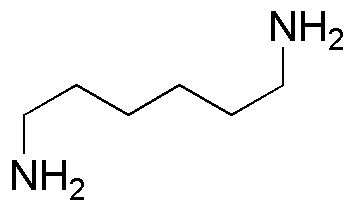|
1,6-Diaminohexane is widely utilized in research focused on:
- Polymer Production: It serves as a key building block in the synthesis of polyamides, which are essential in producing durable materials like nylon. This application is particularly valuable in the textile and automotive industries.
- Pharmaceuticals: The compound is used in the development of various pharmaceuticals, including anti-cancer agents. Its ability to form stable complexes with metal ions enhances drug efficacy.
- Adhesives and Sealants: 1,6-Diaminohexane is incorporated into epoxy formulations to improve adhesion properties, making it ideal for construction and manufacturing applications.
- Coatings: It is utilized in the production of protective coatings that resist corrosion and wear, benefiting industries such as aerospace and marine.
- Research Reagents: The compound is employed as a reagent in organic synthesis and analytical chemistry, aiding researchers in developing new compounds and conducting experiments.
General Information
Properties
Safety and Regulations
Applications
1,6-Diaminohexane is widely utilized in research focused on:
- Polymer Production: It serves as a key building block in the synthesis of polyamides, which are essential in producing durable materials like nylon. This application is particularly valuable in the textile and automotive industries.
- Pharmaceuticals: The compound is used in the development of various pharmaceuticals, including anti-cancer agents. Its ability to form stable complexes with metal ions enhances drug efficacy.
- Adhesives and Sealants: 1,6-Diaminohexane is incorporated into epoxy formulations to improve adhesion properties, making it ideal for construction and manufacturing applications.
- Coatings: It is utilized in the production of protective coatings that resist corrosion and wear, benefiting industries such as aerospace and marine.
- Research Reagents: The compound is employed as a reagent in organic synthesis and analytical chemistry, aiding researchers in developing new compounds and conducting experiments.
Documents
Safety Data Sheets (SDS)
The SDS provides comprehensive safety information on handling, storage, and disposal of the product.
Product Specification (PS)
The PS provides a comprehensive breakdown of the product’s properties, including chemical composition, physical state, purity, and storage requirements. It also details acceptable quality ranges and the product's intended applications.
Certificates of Analysis (COA)
Search for Certificates of Analysis (COA) by entering the products Lot Number. Lot and Batch Numbers can be found on a product’s label following the words ‘Lot’ or ‘Batch’.
*Catalog Number
*Lot Number
Certificates Of Origin (COO)
This COO confirms the country where the product was manufactured, and also details the materials and components used in it and whether it is derived from natural, synthetic, or other specific sources. This certificate may be required for customs, trade, and regulatory compliance.
*Catalog Number
*Lot Number
Safety Data Sheets (SDS)
The SDS provides comprehensive safety information on handling, storage, and disposal of the product.
DownloadProduct Specification (PS)
The PS provides a comprehensive breakdown of the product’s properties, including chemical composition, physical state, purity, and storage requirements. It also details acceptable quality ranges and the product's intended applications.
DownloadCertificates of Analysis (COA)
Search for Certificates of Analysis (COA) by entering the products Lot Number. Lot and Batch Numbers can be found on a product’s label following the words ‘Lot’ or ‘Batch’.
*Catalog Number
*Lot Number
Certificates Of Origin (COO)
This COO confirms the country where the product was manufactured, and also details the materials and components used in it and whether it is derived from natural, synthetic, or other specific sources. This certificate may be required for customs, trade, and regulatory compliance.


